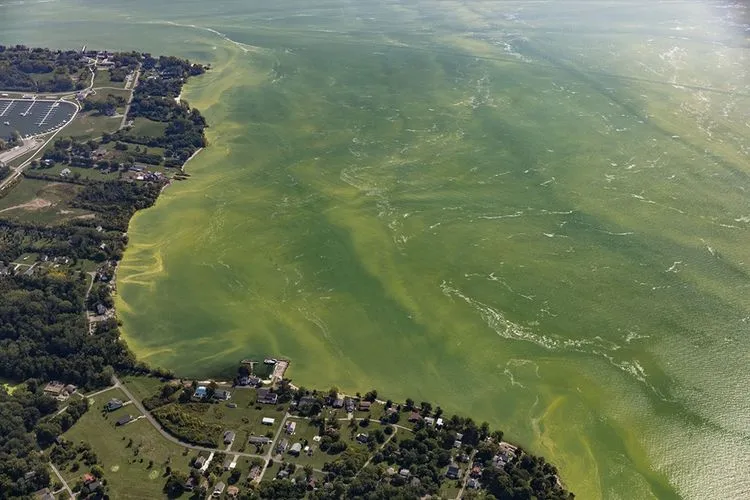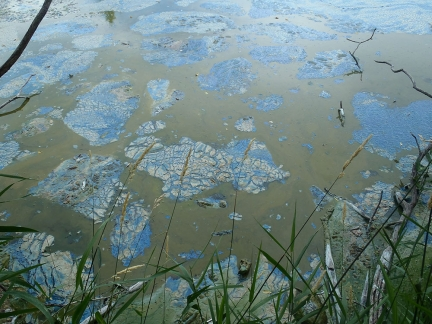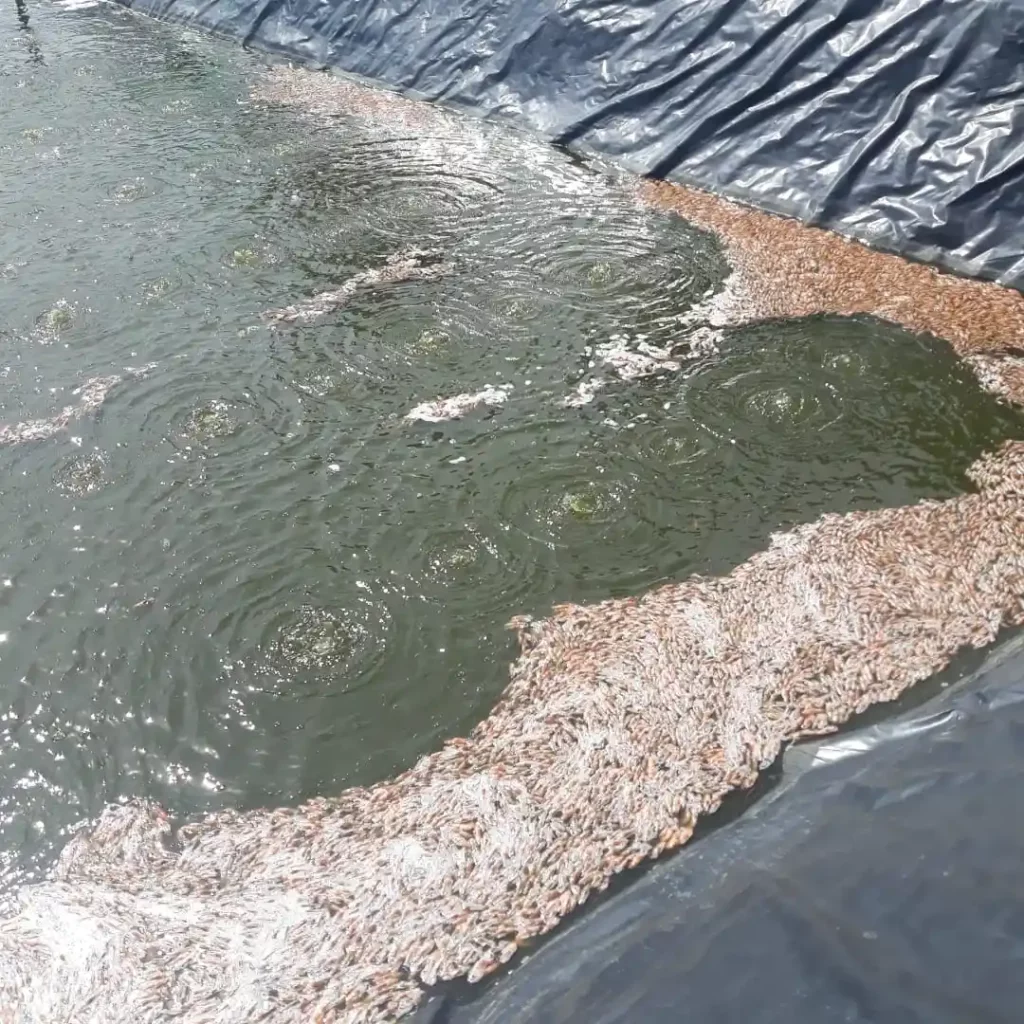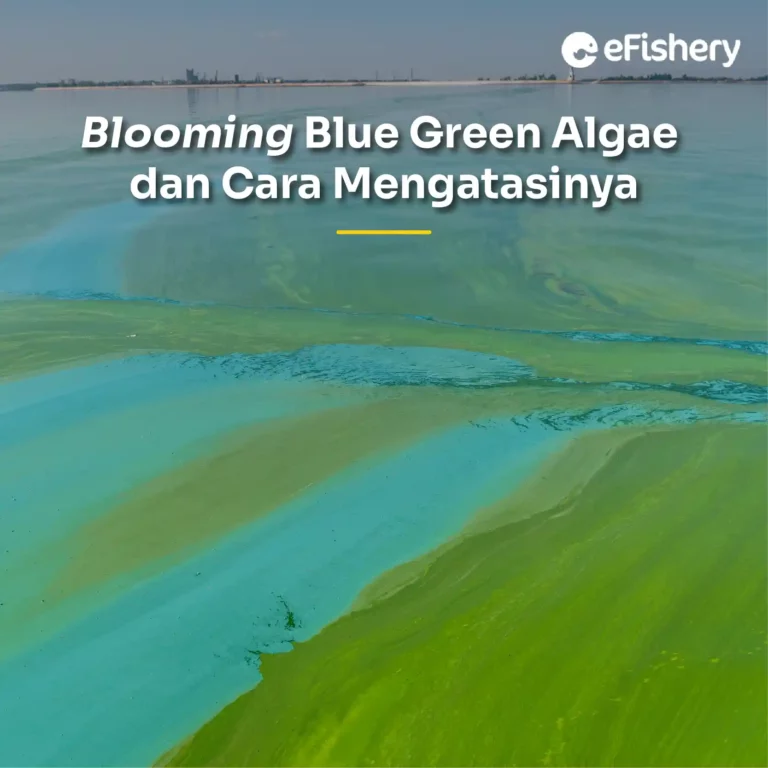Artikel Ini Telah Direview Oleh:

Anggie Nur
Magister Bioteknologi

Nabilla Anggi
Magister Budidaya Perairan
Blue green algae is a type of phytoplankton that you must be aware of. Although usually phytoplankton is used as natural food for shrimp, this type of phytoplankton can interfere with shrimp health, especially when there are too many of them. Come on, get to know more about blue green algae through this article!
What is Blue Green Algae?

Blue green algae or commonly called cyanobacteria is a type of phytoplankton that gets energy through the process of photosynthesis. The green blue color that appears is caused by the presence of a combination of chlorophyll and phycocyanin pigments. Blue green algae (BGA) reproduce through the process of cell division and spore formation. BGA usually lives in fresh, brackish and salt water at a temperature of 25-35 °C with a water pH of 7.5-9.
Blue green algae can harm the growth of shrimp because it can produce dangerous toxins and can damage the hepatopancreas tissue. If eaten directly by shrimp, blue green algae can cause disease.
However, not all species of blue green algae are harmful to shrimp. There are several BGAs that have an important role.
One of them is its ability to increase dissolved oxygen levels in pond water produced through the process of photosynthesis. This phytoplankton also has the potential to be a bioindicator that indicates the good and bad of a pond.
What is Blooming Algae?

Blooming algae adalah istilah lain dari ledakan alga di suatu perairan baik kolam, tambak, ataupun danau. Blooming cyanobacteria atau blue green algae umumnya dapat terjadi pada perairan yang memiliki rasio nitrogen dan fosfor yang tinggi. Genus yang ditemukan mendominasi BGA adalah Microcystis sp. dan Synechococcus sp.
However, at a low ratio of nitrogen and phosphorus, the cyanobacteria bloom was dominated by Oscillatoria sp. and Anabaena sp. This happens because of the ability of the cells to fix nitrogen from the air. The main material for forming Cyanobacteria is the availability of phosphorus (P), so that the higher the availability of phosphorus, the density of cyanobacteria will also increase.
Although it can increase the oxygen content in pond water, blue green algae is very dangerous for pond ecosystems if there are too many of them. Large populations or blooming algae can turn into a very deadly poison for shrimp, especially when die-off occurs after blooming.
If the shrimp pond water is green, it means that the total population of phytoplankton which acts as the shrimp's natural food is at a safe level. However, if the shrimp pond water is bluish in color, blue green algae are indicated to be experiencing an explosion or blooming. This event is known to be rare, but you still have to be careful, okay!
Causes of the Appearance of Blue Green Algae
Blue green algae have the unique ability to float on the surface of pond water, making it easier to access nutrients and light. This ability also makes it dominate the plankton population in the pond, causing a population explosion or bloom.
In addition, blooming algae is caused by excess nitrogen and phosphorus content in pond water. This excess nitrogen and phosphorus comes from uneaten feed residue which then settles and accumulates at the bottom of the pond. The amount of BGA is often more dominant because this type of phytoplankton is able to secrete substances that can inhibit the growth of other phytoplankton.
Other factors that trigger the emergence of blue green algae include high concentrations of organic matter, erratic temperatures, too high light intensity, alkaline water, and low salinity levels (<10 ppt).
The Impact of the Emergence of Blue Green Algae

One of the bad consequences of excessive growth of blue green algae is the accumulation of organic matter at the bottom of the pond and a drastic decrease in oxygen levels when algae die en masse. This can lead to the accumulation of toxic compounds such as ammonia, nitrites, and hydrogen sulfide.
In fact, several types of blue green algae are capable of producing toxins that are harmful to the digestion process of shrimp. If it attacks the digestion of shrimp, it will cause the emergence of White Feces Disease which can result in mass death of shrimp.
How to Prevent and Overcome Blue Green Algae
One way to prevent the appearance of excess blue green algae is to provide enough feed, not less and not more. This is because excess feed residue will settle to the bottom of the pond and cause nitrogen and phosphorus to arise which can trigger the growth of BGA.
If your pond has experienced an explosion or blooming blue green algae, deal with it as soon as possible to prevent shrimp death. To prevent and overcome blooming algae, pay attention to the following ways:
- Maintain and improve water quality regularly because blue green algae have a strong relationship with pH, temperature and nutrients.
- Circulating water to dilute the BGA density.
- Give Aqualisan disinfectant to kill BGA, then do siphoning.
- Increase the salinity of pond water because some types of BGA cannot stand high salinity, but still pay attention to the optimal salinity range for shrimp.
- Reducing the intensity of light in the pond by adding a roof or black waring over the pond. This is done to prevent the growth of BGA which can get energy through photosynthesis.
- Implementing biofloc system cultivation. By cultivating the biofloc system, you can stimulate microbial growth which can convert nitrogenous waste into natural food for shrimp.
- Do water recirculation to dilute the density of BGA
Get Assistance on Shrimp Cultivation in the Cultivation Consultation Feature!
Need Help Regarding Shrimp Cultivation Business?
Fill in your personal data in the following form. Our team will immediately contact you via the number cellphone attached. Make sure the data entered is correct.
Ledakan atau blooming blue algae memang sangat berbahaya bagi udang, terlebih bisa menyebabkan kematian masal. Untuk itu, jika Bapak/Ibu melihat tanda-tanda kemunculan BGA di tambak udang, segera lakukan konsultasi dengan ahli Akuakultur. Melalui fitur Cultivation Consultation that's in the app eFarm from eFishery, you can consult about various kinds of cultivation problems that you experience.
eFarm is the application of eFishery which provides various solutions for your shrimp farming problems. Besides being able to consult directly with an Aquaculture expert, in the application eFarm You can also get quality disinfectants/probiotics to eradicate BGA growth in ponds.
Download the application eFarm in Google Play Store Now!

Anggie Nur - Magister Bioteknologi
Anggie merupakan lulusan sarjana dan magister bioteknologi serta memiliki pengalaman riset di dunia perikanan khususnya udang

Nabilla Anggi - Magister Budidaya Perairan
Nabilla merupakan lulusan sarjana dan magister budidaya perairan serta memiliki pengalaman di dunia perikanan baik hatchery maupun pembesaran
- http://ewinasis.blogspot.com/2012/06/pengaruh-cyanophyta-blue-green-algae.html
- https://cvpradiptaparamita.com/blooming-blue-green-algae/#:~:text=Blooming%20Blue%20Green%20Algae%20
- https://www.isw.co.id/post/2019/07/24/blooming-alga-pada-tambak-udang
